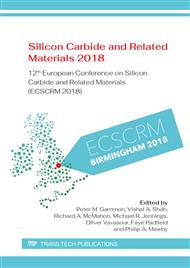p.244
p.251
p.255
p.259
p.263
p.268
p.272
p.276
p.280
Dynamics Analysis of Single Shockley Stacking Fault Expansion in 4H-SiC P-i-N Diode Based on Free Energy
Abstract:
Expansion of single Shockley stacking faults (SSFs) during forward current operation is an important issue, because it decreases the reliability of 4H-SiC bipolar devices. In this paper, we propose a method for analyzing SSF dynamics based on free energy under current conduction, temperature, and resolved shear stress conditions. The driving force for dislocation dissociation reactions and formation of SSFs is incorporated into the free energy function, including chemical potential, stacking fault energy, crystallographic energy, gradient energy and elastic strain energy. The net energy gain of the chemical potential was calculated as a function of temperature and current conduction through use of the a TCAD device simulator based on the Boltzmann equation, Poisson equation and the current continuity equation concerning electron and hole distributions with self-consistency. It was confirmed that SSF dynamics can be simulated by the proposed method. It was also found that SSF formation can be attributed to quantum well variation in which electrons in n-type 4H–SiC enter SSF-induced quantum well states to lower the energy of the dislocation system.
Info:
Periodical:
Pages:
263-267
Citation:
Online since:
July 2019
Authors:
Price:
Сopyright:
© 2019 Trans Tech Publications Ltd. All Rights Reserved
Share:
Citation:


